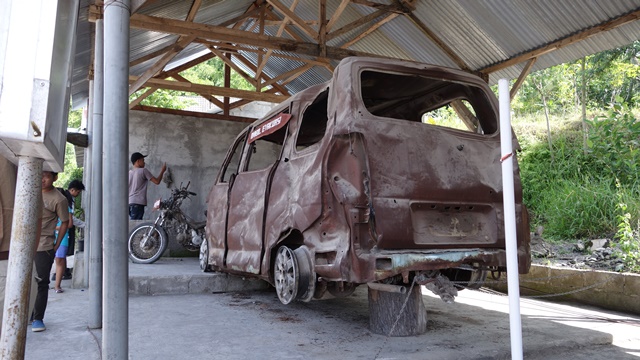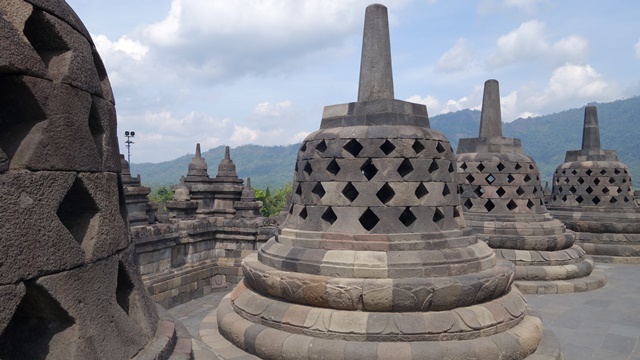30 September 2010
A team of leading researchers from the Russian scientific community told a media gathering in Jakarta on Thursday that the hot mud disaster in Sidoarjo, East Java, which has wrought destruction over a large area and forced the evacuation of tens of thousands of local residents, could not have been caused by the drilling of a gas well in the area, as claimed by some researchers. In a report released today, the team concluded that the eruption was the direct result of the reactivation of a centuries’ old mud volcano, triggered by seismic events.
Led by Dr. Sergey V. Kadurin, a senior lecturer at Odessa University, Ukraine, the team comprise of leading scientists from the Russian Institute of Electro Physics. The scientists were in Jakarta to present the research findings based on previously unreleased seismic data provided by the Indonesian Government. The seismic data was obtained in the period leading up to the eruption of the area known commonly as LUSI (a compendium of the Indonesian word for mud "Lumpur" and "Sidoarjo"), and provided crucial evidence on which the study is based.
The report finds that LUSI is the reactivation of an old mud volcano structure that was formed around 150,000 - 200,000 years ago, and the current eruption, which began on May 29, 2006 and has continued almost unabated since, was triggered by a series of seismic events that began some 10 months before LUSI erupted.
The detailed study of earthquake points has shown that LUSI was preceded by several forceful seismic events that accelerated the channeling of the mud formation through the existing mud structures and between fault structures. "The earthquake nearly one year before the LUSI eruption would have been one of the geological events assisting the opening of the mud channels. The continuous Watukosek fault movement would have further assisted this process. And the earthquake two days before the eruption would have been the final kick off," said Dr. Kadurin.
A number of Indonesian and international geologists have studied the LUSI phenomenon but there have been varying conclusions regarding the cause of the disaster, resulting in a long-running international controversy. While some scientists have identified the eruption as a mud volcano triggered by a powerful earthquake two days earlier in Yogyakarta, Central Java, others have steadfastly maintained that the eruption was caused by a "blow-out" in a gas exploration well some 200 meters from the site of LUSI. According to Dr. Kadurin, both of these theories are flawed.
The Russian research team had constructed a Geological Information System (GIS), which allowed them to create a 3D model of the underground geological formations in the area. This allowed the team to have a virtual picture of the source of the mud and how it is being channeled to the surface. With this 3D imaging, the team was able to ultimately prove or disprove the various theories that have been floating about LUSI over the past four years.
According to the data, about 10 months before the LUSI eruption on July 9, 2005, there was an earthquake with its epicenter directly beneath the LUSI mud eruption zone with a magnitude of 4.4 on the Richter scale. This was followed by another earthquake 16 days before the LUSI eruption about 450 km away with magnitude of 5.5. And as is already commonly known, on May 27, 2006, two days before LUSI eruption, there was an earthquake of 6.3 magnitude about 185 km from LUSI’s location in Yogyakarta, Central Java. Based on its findings, it was a combination of these seismic disturbances that reactivated the old mud volcano.
"By wrongly assuming that the drilling caused the mud eruption, the authorities are in danger of neglecting possible upcoming disasters and may fail to take appropriate anticipatory actions, which might include the evacuation of people in nearby areas," said Dr. Kadurin. "It can be concluded as indisputable fact that in the case of the mud volcano LUSI, the mud channel has existed long before the drilling of the wells. In fact there are two main channels with three potential eruption points that can be observed from the 3D view of the sub terrain."
"The interest of the scientists’ study, in addition to their desire to help the Indonesian people in solving problems caused by mud volcanoes in Java, is one more demonstration of the long standing friendship and cooperation between Russia and Indonesia," said the Russian team spokesman Boris Gromov. "Russia also has vast experience in managing mud volcanoes where hundreds exist in areas rich in hydrocarbons, such as in Central Asia."
The research was initiated after a state visit by Russian President Vladimir Putin to Jakarta in September 2007, which called for greater cooperation between Moscow and Jakarta in a number of areas, including scientific research. The research results were recently published in Russia after having been verified by a team of 20 independent senior scientists from the Russian Geological Research Institute (VSEGEI), the Russian Government’s highest authority on geological issues, which was created in 1882 in St Petersburg, Russia.
The research findings were presented to the Indonesian government agency appointed to mitigate the effects of LUSI (BPLS), Indonesian geologists as well as officials from OOO Rineftgaz, a Russian government-linked company tasked with managing, co-ordinating and commissioning the Russian geological institutions to research LUSI. Jeffrey Richards and Angus Carnegie from the Humanitus Foundation, an Australian NGO assisting BPLS, were also in attendance. The NGO has established the Humanitus Sidoarjo Fund, which will help finance further scientific investigation of the LUSI phenomenon.
"The purpose of our group is not to start long and fruitless discussions on the causes of the LUSI mud eruption, but to present the well educated opinion of the Russian scientific and governmental institutions on its origin, the ways of handling LUSI and probable other future disasters with minimal human loss and economic damage. However we are fully prepared to answer any questions that might arise with regard to the LUSI phenomenon," Mr. Gromov concluded.







